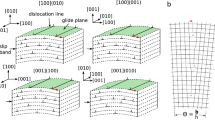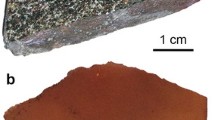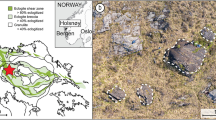Abstract
Intracrystalline distortions (like undulose extinction, dislocations, and subgrain boundaries) in olivine from naturally-deformed peridotites are generally taken as signs of dislocation creep. However, similar features in olivine phenocrysts that have been found in basaltic magmas are still not well understood. In particular, whether subgrain boundaries in olivine phenocrysts arise from plastic deformation or grain growth is still debated (in the latter case, they are essentially grain boundaries but not subgrain boundaries. Therefore, we used hereinafter subgrain-boundary-like structures instead of subgrain boundaries to name this kind of intracrystalline distortion). Here we carried out a detailed study on dislocations and subgrain-boundary-like (SG-like) structures in olivine phenocrysts from two Hawaiian basaltic lavas by means of petrographic microscopy, scanning electron microscopy, and transmission electron microscopy (TEM). Abundant and complex dislocation substructures (free dislocations, dislocation walls, and dislocation tangles) were observed in the decorated olivine grains, similar to those in olivine from peridotite xenoliths entrained by the Hawaiian basalts. The measured average dislocation density is (2.9±1.3)×1011 m−2, and is three to five orders of magnitude higher than that in laboratory-synthesized, undeformed olivine. TEM observations on samples cut across the SG-like structures by FIB (focused ion beam) demonstrated that this kind of structures is made of an array of dislocations. These observations clearly indicate that these structures are real subgrain boundaries rather than grain boundaries. These facts suggest that the observed high dislocation densities and subgrain boundaries cannot result from crystal crystallization/growth, but can be formed by plastic deformation. These deformation features do not prove that the olivine phenocrysts (and implicitly mantle xenoliths) were deformed after their capture by the basaltic magmas, but can be ascribed to a former deformation event in a dunitic cumulate, which was formed by magmatic fractionation, then plastically deformed, and finally disaggregated and captured by the basaltic magma that brought them to the surface.
Similar content being viewed by others
References Cited
Bai, Q., Kohlstedt, D. L., (1992. High-Temperature Creep of Olivine Single Crystals, 2. Dislocation Structures. Tectonophysics, 206(1/2): 1–29. https://doi.org/10.1016/0040-1951(92)90365-d
Cao, Y., Jung, H. Y., Song, S. G., et al., 2017. Olivine Fabrics and Tectonic Evolution of Fore-Arc Mantles: A Natural Perspective from the Songshugou Dunite and Harzburgite in the Qinling Orogenic Belt, Central China. Geochemistry, Geophysics, Geosystems, 18(3): 907–934. https://doi.org/10.1002/2016gc006614
Clague, D. A., Denlinger, R. P., (1994. Role of Olivine Cumulates in Destabilizing the Flanks of Hawaiian Volcanoes. Bulletin of Volcanology, 56(6/7): 425–434. https://doi.org/10.1007/s004450050052
Davis, G. H., Reynolds, S. J., Kluth, C. F., 2011. Structural Geology of Rocks and Regions. Wiley, New York. 176–178
Durham, W. B., Goetze, C., Blake, B., 1977. Plastic Flow of Oriented Single Crystals of Olivine: 2. Observations and Interpretations of the Dislocation Structures. Journal of Geophysical Research, 82(36): 5755–5770. https://doi.org/10.1029/jb082i036p05755
Falus, G., Tommasi, A., Ingrin, J., et al., (2008. Deformation and Seismic Anisotropy of the Lithospheric Mantle in the Southeastern Carpathians Inferred from the Study of Mantle Xenoliths. Earth and Planetary Science Letters, 272(1/2): 50–64. https://doi.org/10.1016/j.epsl.2008.04.035
Farla, R. J. M., Kokkonen, H., Fitz Gerald, J. D., et al., 2010. Dislocation Recovery in Fine-Grained Polycrystalline Olivine. Physics and Chemistry of Minerals, 38(5): 363–377. https://doi.org/10.1007/s00269-010-0410-3
Green, H. W. II, Radcliffe, S. V., 1972. Dislocation Mechanisms in Olivine and Flow in the Upper Mantle. Earth and Planetary Science Letters, 15(3): 239–247. https://doi.org/10.1016/0012-821x(72)90169-0
Gueguen, Y., (1977. Dislocations in Mantle Peeidotite Nodules. Tectonophysics, 39(1/2/3): 231–254. https://doi.org/10.1016/0040-1951(77)90098-1
Gueguen, Y., Darot, M., 1980. Microstructures and Stresses in Naturally Deformed Peridotites, In: Scheidegger, A. E., ed., Tectonic Stresses in the Alpine-Mediterranean Region. Springer, Vienna. 159–172
Hanson, D. R., Spetzler, H. A., 1994. Transient Creep in Natural and Synthetic, Iron-Bearing Olivine Single Crystals: Mechanical Results and Dislocation Microstructures. Tectonophysics, 235(4): 293–315. https://doi.org/10.1016/0040-1951(94)90191-0
Hanson, D. R., Young, M., Ryerson, F. J., 1991. Growth and Characterization of Synthetic Iron-Bearing Olivine. Physics and Chemistry of Minerals, 18(1): 53–63. https://doi.org/10.1007/bf00199044
Helz, R., 1987. Diverse Olivine Types in Lava of the 1959 Eruption of Kilauea Volcano and Their Bearing on Eruption Dynamics. U.S. Geological Survey Professional Paper, 1350: 691–722
Hosoya, S., Takei, H., 1982. Floating-Zone Growth of Single-Crystal Olivine [(Mg1-XFex)2SiO4]. Journal of Crystal Growth, 57(2): 343–348. https://doi.org/10.1016/0022-0248(82)90489-4
Jung, H., Karato, S. I., 2001. Water-Induced Fabric Transitions in Olivine. Science, 293(5534): 1460–1463. https://doi.org/10.1126/science.1062235
Karato, S. I., Sato, H., (1982. Effect of Oxygen Partial Pressure on the Dislocation Recovery in Olivine: A New Constraint on Creep Mechanisms. Physics of the Earth and Planetary Interiors, 28(4): 312–319. https://doi.org/10.1016/0031-9201(82)90088-7
Kohlstedt, D. L., Goetze, C., Durham, W. B., et al., 1976. New Technique for Decorating Dislocations in Olivine. Science, 191(4231): 1045–1046. https://doi.org/10.1126/science.191.4231.1045
Mackwell, S. J., Bai, Q., Kohlstedt, D. L., 1990. Rheology of Olivine and the Strength of the Lithosphere. Geophysical Research Letters, 17(1): 9–12. https://doi.org/10.1029/g1017i001p00009
Müntener, O., Piccardo, G. B., 2003. Melt Migration in Ophiolitic Peridotites: The Message from Alpine-Apennine Peridotites and Implications for Embryonic Ocean Basins. Geological Society, London, Special Publications, 218(1): 69–89. https://doi.org/10.1144/gsl.sp.2003.218.01.05
Nielsen, T. F. D., 1981. The Ultramafic Cumulate Series, Gardiner Complex, East Greenland. Contributions to Mineralogy and Petrology, 76(1): 60–72. https://doi.org/10.1007/bf00373684
Park, Y., Jung, H., (2014. Deformation Microstructures of Olivine and Pyroxene in Mantle Xenoliths in Shanwang, Eastern China, near the Convergent Plate Margin, and Implications for Seismic Anisotropy. International Geology Review, 57(5/6/7/8): 629–649. https://doi.org/10.1080/00206814.2014.928240
Sakyi, P. A., Tanaka, R., Kobayashi, K., et al., 2012. Inherited Pb Isotopic Records in Olivine Antecryst-Hosted Melt Inclusions from Hawaiian Lavas. Geochimica et Cosmochimica Acta, 95: 169–195. https://doi.org/10.1016/j.gca.2012.07.025
Soustelle, V., Manthilake, G., 2017. Deformation of Olivine-Orthopyroxene Aggregates at High Pressure and Temperature: Implications for the Seismic Properties of the Asthenosphere. Tectonophysics, 694: 385–399. https://doi.org/10.1016/j.tecto.2016.11.020
Soustelle, V., Tommasi, A., Demouchy, S., et al., (2010. Deformation and Fluid-Rock Interaction in the Supra-Subduction Mantle: Microstructures and Water Contents in Peridotite Xenoliths from the Avacha Volcano, Kamchatka. Journal of Petrology, 51(1/2): 363–394. https://doi.org/10.1093/petrology/egp085
Tommasi, A., Ishikawa, A., 2014. Microstructures, Composition, and Seismic Properties of the Ontong Java Plateau Mantle Root. Geochemistry, Geophysics, Geosystems, 15(11): 4547–4569. https://doi.org/10.1002/2014gc005452
Toriumi, M., 1979. Relation between Dislocation Density and Subgrain Size of Naturally Deformed Olivine in Peridotites. Contributions to Mineralogy and Petrology, 68(2): 181–186. https://doi.org/10.1007/bf00371899
Tribuzio, R., Tiepolo, M., Fiameni, S., 2008. A Mafic-Ultramafic Cumulate Sequence Derived from Boninite-Type Melts (Niagara Icefalls, Northern Victoria Land, Antarctica). Contributions to Mineralogy and Petrology, 155(5): 619–633. https://doi.org/10.1007/s00410-007-0261-1
Vinet, N., Flemming, R. L., Higgins, M. D., 2011. Crystal Structure, Mosaicity, and Strain Analysis of Hawaiian Olivines Using in situ X-Ray Diffraction. American Mineralogist, 96(4): 486–497. https://doi.org/10.2138/am.2011.3593
Vinet, N., Higgins, M. D., 2010. Magma Solidification Processes beneath Kilauea Volcano, Hawaii: A Quantitative Textural and Geochemical Study of the 1969–1974 Mauna Ulu Lavas. Journal of Petrology, 51(6): 1297–1332. https://doi.org/10.1093/petrology/egq020
Wang, Y. -F., Zhang, J. F., Shi, F., 2013. The Origin and Geophysical Implications of a Weak C-Type Olivine Fabric in the Xugou Ultrahigh Pressure Garnet Peridotite. Earth and Planetary Science Letters, 376: 63–73. https://doi.org/10.1016/j.epsl.2013.06.017
Welsch, B., Faure, F., Famin, V., et al., 2013. Dendritic Crystallization: A Single Process for All the Textures of Olivine in Basalts?. Journal of Petrology, 54(3): 539–574. https://doi.org/10.1093/petrology/egs077
Wen, D. -P., Wang, Y. -F., Zhang, J. F., et al., 2018. Anisotropic Growth of Olivine during Crystallization in Basalts from Hawaii: Implications for Olivine Fabric Development. American Mineralogist, 103(5): 735–741. https://doi.org/10.2138/am-2018-6174
Zaffarana, C., Tommasi, A., Vauchez, A., et al., 2014. Microstructures and Seismic Properties of South Patagonian Mantle Xenoliths (Gobernador Gregores and Pali Aike). Tectonophysics, 621: 175–197. https://doi.org/10.1016/j.tecto.2014.02.017
Acknowledgments
We thank Prof. Junfeng Zhang for providing us the samples and Haijun Xu for maintaining the SEM and EBSD systems. Professor Tao Chen is greatly thanked for her help during sample preparation by FIB. Insightful comments by two anonymous reviewers are helpful to improve the manuscript and acknowledged. This work was sponsored by the National Natural Science Foundation of China (Nos. 41590623, 41972231, 41872230). The final publication is available at Springer via https://doi.org/10.1007/s12583-020-1338-2.
Author information
Authors and Affiliations
Corresponding authors
Rights and permissions
About this article
Cite this article
Li, ZY., Wen, DP., Wang, YF. et al. An Investigation of Dislocation in Olivine Phenocrysts from the Hawaiian Basalts. J. Earth Sci. 31, 1183–1189 (2020). https://doi.org/10.1007/s12583-020-1338-2
Received:
Accepted:
Published:
Issue Date:
DOI: https://doi.org/10.1007/s12583-020-1338-2




